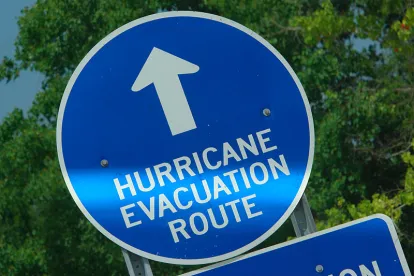Hurricanes Harvey and Irma delivered one of Mother Nature’s most powerful one-two punches in U.S. history. Harvey struck first. On August 25, 2017, the storm made landfall near the Texas Gulf Coast as a Category 4 Hurricane and began its slow easterly crawl. By the time Harvey became a depression 117 hours after landfall, areas in southeast Texas had been subjected to wind gusts around 100 mph, tornados, tens of inches of rain, powerful storm surges and massive flooding. While Texas was hit hardest, Harvey did not spare Louisiana. Exactly 12 years after Hurricane Katrina, Louisiana was again battered by devastating wind and water.
Just as Harvey was winding down, satellite imagery showed another storm brewing in the Atlantic. Within 24 hours, that storm became Hurricane Irma. After wreaking unprecedented havoc in the Caribbean for days, Irma arrived on the shores of the United States as a Category 4 Hurricane on September 10. As Irma made its way up the length of Florida, many areas were exposed to wind gusts of 70−90 mph, tornadoes, torrential rain, storm surges and vast flooding. Similar to Harvey, Irma retained enough energy to bring its destructive forces into a second state. This time, Georgia was the victim.
The rapidity and intensity of these weather conditions led to unprecedented devastation of homes and buildings in these states. The storms seem likely to have caused $150 billion to $200 billion in total damage.
As affected individuals begin to rebuild, they will inevitably look to their insurance carriers for the means to do so. However, many will find to their dismay that not all damages are covered under their policies. While wind damage typically is covered under property insurance, flood insurance usually needs to be purchased separately. Given the immense wind and water damage inflicted by Harvey and Irma, the key question becomes: Is the loss covered by the policy?
Concurrent Causation versus Efficient Proximate Cause
The answer to that question may depend on which side of the Texas-Louisiana and Florida-Georgia borders the insured property falls. The reason is that these states employ different doctrines when determining whether coverage exists when both a covered cause and excluded cause combine to create the property loss. While Texas and Florida adhere to the doctrine of concurrent causation, Georgia and Louisiana employ the doctrine of efficient proximate cause.
The concurrent causation versus efficient proximate cause issue was touched upon briefly in a recent posting “Is There a Silver Lining with Hurricane Irma?” Under the doctrine of concurrent causation, followed by a minority of jurisdictions, a loss caused by multiple perils is recoverable when at least one peril is covered under the policy, even if multiple perils are excluded. Thus, when a determination is made that the loss would not have occurred “but for” a covered peril, then the claim will be covered.
Conversely, the doctrine of efficient proximate cause adhered to by a majority of jurisdictions permits coverage only when a covered peril is the “leading” or “predominant” cause of the loss. If the covered peril is merely a contributor, the peril may not be considered in determining whether coverage exists. As a result, after a court determines the predominant cause of the loss, coverage then depends on whether the predominant cause is covered or excluded.
To shed light on the impact these two approaches will have on individuals affected by Harvey and Irma, it helps to consider a hypothetical:
Contemplate a scenario in which Neighbor A, whose insured property lies in Texas, and Neighbor B, whose insured property is located in Louisiana, have similar standard property insurance policies and have sustained significant damage to their properties as a result of Hurricane Harvey’s wind and flooding. Neighbor A’s loss is more likely to be covered than Neighbor B’s loss because Texas employs the insured-friendly doctrine of concurrent causation. Similarly, if Neighbor A’s insured property is in Florida and Neighbor B’s insured property is in Georgia, then, again, Neighbor A is more likely than Neighbor B to recover for the property damages resulting from the wind and flooding brought by Hurricane Irma.
Anti-Concurrent Causation Clauses
Despite these important differences, which doctrine a jurisdiction employs may be inconsequential if the jurisdiction views the doctrine as merely a default rule. In such jurisdictions, insurers may insert language, known as an Anti-Concurrent Causation (ACC) clause, into the policy to circumvent the applicable doctrine and preclude recovery in all instances in which an excluded cause contributes to the loss. The ACC clause issue also was briefly touched upon in the article referenced above. For example, an ACC clause at issue as a result of Harvey or Irma may read, “Damage caused by flooding is excluded regardless of whether any other cause or event contributed concurrently or in any sequence to the loss.”
While there is a split of authority in Louisiana as to the enforceability of ACC clauses, the highest courts in Texas and Florida recently found that ACC clauses are valid. Although Georgia’s highest court has not ruled on the issue, courts applying Georgia law also have found such clauses to be enforceable. Thus, Neighbor A’s greater likelihood for coverage in the above examples may be negated by the inclusion of an ACC clause.
Valued Policy Laws
Valued Policy Laws (VPLs) may provide some policyholders with a weapon to counter the ACC clauses in the coming Harvey and Irma coverage disputes. In general, VPLs require a property insurer to pay the face amount of an insurance policy when there is a total loss to qualifying insured property caused, at least in part, by a covered peril, regardless of the actual value of the property at the time of the loss. In the past, courts construing their state’s VPLs have found that once there is a determination of a total loss and that a cause of the loss is covered, contribution from an excluded cause will be immaterial even in the face of an ACC clause. The courts reasoned that enforcing the ACC clause would run contrary to the VPL.
Although Texas, Georgia, Florida and Louisiana each have some form of a VPL, the Texas and Georgia statutes only apply in the event of a total loss by fire. Moreover, the Louisiana Supreme Court, in Landry v. Louisiana Citizens Property Ins. Co., 969 So.2d 615 (La. 2007), stated in dicta that Louisiana’s VPL “is intended to apply only to fire insurance policies, which may include coverage against other perils as allowed by La. R.S. 22:691 and is distinct from homeowners’ policies.” Even if a cause is covered by the applicable fire insurance policy or counsel is arguing that Louisiana’s VPL applies to homeowners’ insurance policies despite the dicta in Landry, a second issue may arise for policyholders via the Louisiana VPL’s “opt-out” provision. Under the provision, an insurer may avoid the requirement that it compute and compensate any covered property loss at the valuation used for purposes of determining the premium charged without deduction or offset by setting forth a different method of loss computation in the application and policy.
In Landry, the court found that the insurer opted out of the VPL by sufficiently setting forth a different method for settling covered property losses in the policy, which “clearly indicated that only covered losses were to be settled.” As a result, the court found that the insurer was obligated only to settle the covered property losses, as set forth in the policy, and that the insurer was not obligated to pay the face value of the policy because the different method of loss computation set forth in the policy did not require a payment of face value. Thus, although the policy in Landry contained an ACC clause, the court was able to avoid addressing whether the VPL trumps the ACC clause, stating, “Whether the statutory valuation provisions would require an insurer to pay the face value of the policy when a total loss was caused concurrently by a [sic] covered and non-covered losses was irrelevant because those provisions no longer applied once a different method of loss computation was validly set forth.” Given this decision, there is still an open question as to whether Louisiana’s VPL overrides an ACC clause when the insurer fails to opt out of the VPL.
Florida’s VPL is not limited to fire insurance policies or events in which the total loss was caused by fire. However, in 2005, Florida revised its VPL to state that an insurer’s liability for policy limits is limited to cases in which the covered peril would by itself have been sufficient to create a constructive total loss and cases in which the covered peril actually caused the total loss. Nevertheless, where a covered and non-covered peril combine to create the property loss, an individual may argue that despite the existence of an ACC clause, the property loss is covered because the covered peril alone caused sufficient damage to result in a total loss.
Generally, three methods are used to determine if there has been a total loss:
-
The “identity” test under which a total loss exists when the building has lost its identity and specific character as a building
-
The “restoration” test, which deems a building to be a total loss when a reasonably prudent owner would not use the remains of the structure after the loss as a basis for restoring the building to its pre-loss condition
-
The “constructive total loss” test, under which a total loss exists when a building is only partially destroyed but is damaged to the extent that the law and regulations in force at the time of the loss actually prohibit or prevent the building’s repair.
Courts typically do not limit themselves to one of these. In fact, Louisiana and Florida courts have applied each of the three tests to determine if a total loss occurred.
Takeaways
Given the magnitude of property losses due to a combination of wind and flooding in the wake of Harvey and Irma, there inevitably will be mass litigation over whether such losses are covered by insurance policies. As a matter of best practices, insurers should always carefully look at the policy at issue to determine if there is an ACC clause. If not, coverage may depend on whether the jurisdiction applies the doctrine of concurrent causation or the doctrine of efficient proximate cause. If an ACC clause is included, insurers should be wary of challenges to the enforceability of such clauses in Louisiana and Georgia, where the highest courts have not ruled on the matter. Moreover, if there is ACC language and Louisiana or Florida law controls, insurers should be prepared to defend against arguments that a total loss occurred and that the VPL trumps the ACC clause.
Robert Taylor (Associate-Philadelphia) assisted in researching and drafting this Insight.



 />i
/>i
